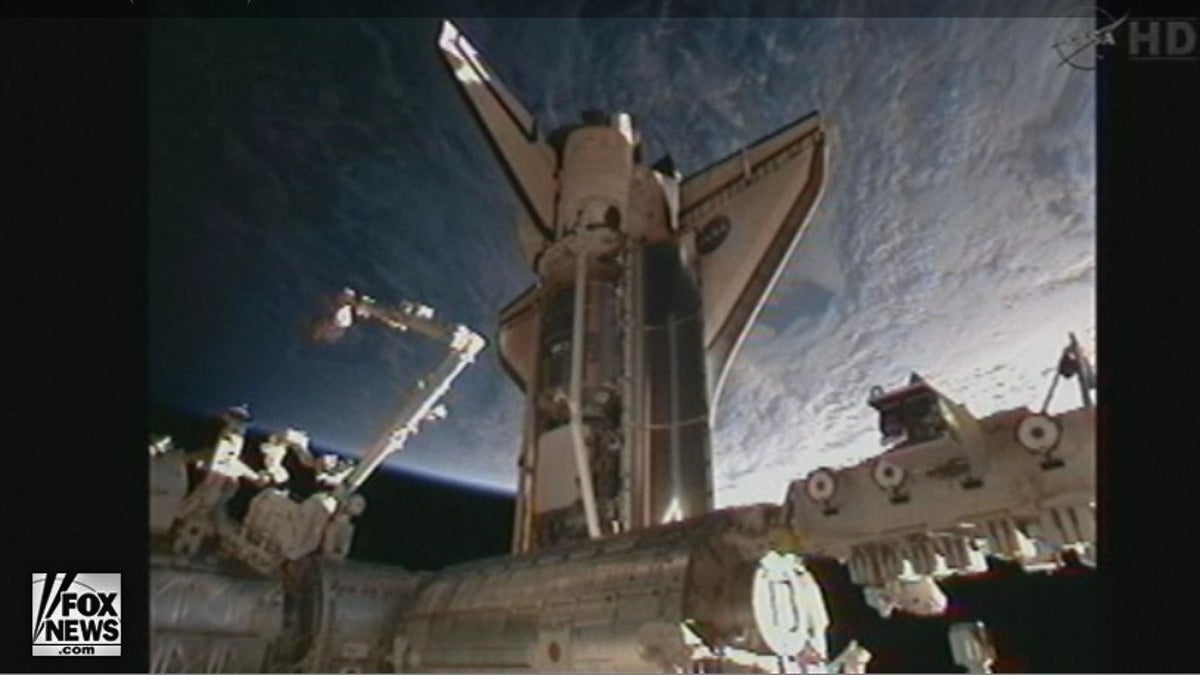
Space shuttle Discovery docked with the International Space Station at 2:14 p.m. EST Saturday.
Space shuttle Discovery docked with the International Space Station for the final time at 2:14 p.m. EST Saturday, where it will make a last delivery to the orbiting space lab -- before parking ultimately at a museum.
The two spacecraft were flying about 220 miles above western Australia at the time they docked for the 11-day mission to deliver supplies, spare parts, an extra storage module and a humanoid robot assistant to the International Space Station. Two spacewalks are also planned during the shuttle's week-long stay at the orbiting lab.
The shuttle and station crews will open hatches and hold the traditional welcome ceremony at about 4:18 p.m.
As Discovery closed in on the orbiting craft, the space station's commander couldn't resist a little ribbing.
"What took you guys so long?" Scott Kelly asked via ship-to-ship radio. Despite racing into space at around 18,000 miles per hour, and docking while orbiting at around the same speed, the ship advanced on the ISS at a snail's pace, creeping in at just 2 tenths of a foot per second.
Earlier in the day, commander Steve Lindsey took the shuttle on a delicate space dance, including a nine-minute Rendezvous Pitch Maneuver (more simply called a backflip) that he began at 1:15 p.m. EST. He fired the ship's rockets one final time earlier in the morning -- the last maneuvers required to place Discovery on the path for its docking.
With Discovery's presence, the ISS becomes a truly "international" space station. This is the first time spacecraft from the United States, Russia, Europe and Japan have all docked simultaneously, NASA said. The station also hosts the Leonardo Multipurpose Module built by the Italian Space Agency and recently gained Dextre, the Canadian Space Agency’s robotic handyman.
"Look who is coming to dinner! STS 133 is headed our way!" space station astronaut Cady Coleman, of NASA, wrote on Twitter after Discovery's Thursday launch.
Discovery's astronaut crew began today's space rendezvous shortly after 8:30 a.m. EST. This will be the 13th and last time Discovery docks at the space station, since the shuttle's STS-133 mission is its final flight before being retired from service.
Before Discovery could park at the orbiting laboratory, Lindsey needed to fly the spacecraft through the slow back flip beneath the space station. This allowed astronauts inside the space station to snap high-resolution photographs of Discovery so that teams on the ground can check the health of Discovery's tile-covered belly, and whether any tiles need repair.
This flip operation has been a part of every NASA shuttle flight since the loss of shuttle Columbia in 2003. Columbia and its seven-astronaut crew perished during re-entry into Earth's atmosphere because of heat shield damage on one of the orbiter's wings.
At least four pieces of debris broke off the fuel tank during Thursday's liftoff, and one of the strips of insulating foam struck Discovery's belly.
NASA officials do not believe the shuttle was damaged. That's because the foam loss occurred so late in the launch, preventing a hard impact. The hundreds of digital pictures snapped by two space station residents should confirm that; experts on the ground will spend the next day or two poring over all the images.
"For rendezvous, I do the manual phase where I take over the vehicle at about 2,000 feet away from space station, fly up to position underneath the space station, do something called an RPM, Rotational Pitch Maneuver, or R-bar Pitch Maneuver, which is basically is just a 360 [degree] back flip so that the space station crew can take pictures of our tiles and make sure they’re okay from a thermal protection systems standpoint," Lindsey said in a NASA interview before launch."Then I’ll fly around the front of the vehicle and manually fly in to do the docking."
The space shuttle's pre-docking flip is one of three separate heat shield inspections built into every shuttle mission.
Yesterday, Discovery astronauts used an inspection boom and their shuttle's robotic arm to survey the heat shield panels along their spacecraft's wings and nose cap. A similar scan will be performed shortly after the shuttle undocks from the space station later in the mission.
NASA officials have said that, based on their initial look, Discovery's heat shield appears to be in good shape after its Thursday launch.
* Photos: Space Shuttle Discovery Launches on Final Voyage
* Video - Discovery's Final Blast Into Space
* Vote Now: The 21st Century's Greatest Space Innovators
Space.com and news wires contributed to this report.
